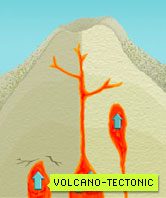
|
|
Volcano-Tectonic Event
Pressure from a pool of magma has just cracked solid rock,
creating a volcano-tectonic (VT) event. This type of quake
produces relatively high-frequency shaking, usually between
one and five cycles per second.
An increase in VT activity is often an early sign that a
volcano is becoming active. This type of restlessness,
however, can last anywhere from days to years, so it's not a
reliable way to predict when a volcano might erupt.
|

A VT event occurs when magma under pressure or cooling rock causes
rock to crack or slip. The abrupt motion of the rock causes its
seismic signal to appear abruptly on a seismogram. Even though the
way they are produced is different, seismograms produced by
volcano-tectonic earthquakes look like those produced by typical
earthquakes (those caused by the motion of tectonic plates at plate
boundaries, such as the San Andreas fault and the Mid-Atlantic
Ridge).
VT events cycle as many as five times a second, particularly if the
earthquake is two kilometers (1.2 miles) or more below the surface.
The frequency of the VT signal shown here is five cycles per second.
Volcano-Tectonic Event
| Long Period Event |
Tremor |
Hybrid
|
|


